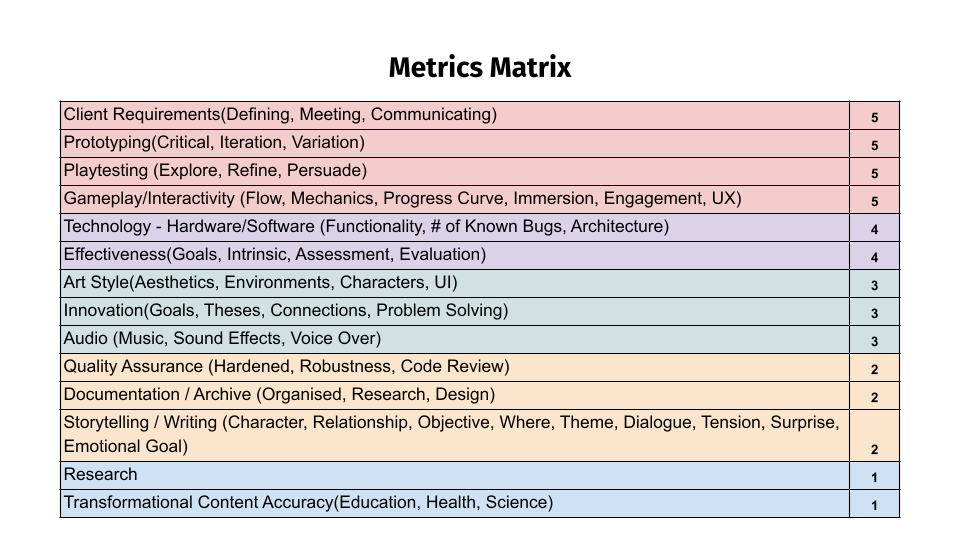During Week 3, we had our 1/4s presentation and our team was visited by the ETC faculty. They passed by in groups to give us feedback on our process and progress.
We spent the early few days of the week preparing for the presentation and the last few days consolidating and discussing the critique and feedback of 1/4s that we received.
In our 1/4 presentation, we discussed our experience goals, game, and UI design iterations, rapid prototyping process, demo presentation, initial user research, playtests with surrogate guests, and data analytics.
We also presented our metrics matrix which defined our priorities:
- Client Requirements
- Prototyping
- Playtesting
- Gameplay/Interactivity

We presented live demos of 3 game ideas from the 5 ideas that we had worked on in the previous week. These 3 ideas were our client’s favorite- Pilot, Bull, and Manipulation.
The prototypes included some art assets but mainly focused on game mechanics using the eye tracker and had the potential of getting interesting analytics.
Our presentation can be found below.
We compiled the feedback and discussed how we would consolidate them. We found some answers and found new questions that needed to be proposed.
Some points raised by the faculty included-
- Skill Mastery – What is the definition of success? How do you define being good or bad at something? How do you get someone from being bad to being good? How do you isolate moments of skill execution? Can you measure these moments? How do you design parameters that can be meaningfully interpreted.
- Nature of Gaze – What does the eyes naturally do? Eye movement is heavily controlled by the subconsciousness. Eye tiredness is an indicator of unnatural movement. When do we let the eye gather info versus dictate intent? How do people naturally want to navigate a new environment? Keep game scenes clean and easy to follow. Utilise indirect control and visual clues to guide.
- Non-intuitive Click – Better understanding the circumstance. How does the circumstance of a brain-controlled click differ from a well known input? What are the response boundaries of the target hardware? Do we want to accommodate these boundaries, or push them? How can we mimic the learning of reaction time? Usage of a surrogate for able-bodied players.
We continued discussing the faculty’s feedback with our clients and gathered information about the reaction time of the BCI (Brain-Computer Interface) click and the speed of double BCI click. We found out that the BCI click could be a slow as a few seconds. We kept this in consideration while designing the game and have moved away from interactions that might require double-clicking or holding.
During quarters, there was a proposition of having separate minigames focusing on different analytics. For example, one mini-game would be focused on accuracy and another minigame would be focused on reaction time.
This method would allow us to train the patient for each analytic equally without overtraining in any one skill. It would also make it easy for the researcher to track the success of each analytic. We brainstormed how we could incorporate mini-games in our existing ideas and came with with a new idea called the Hero-Bull where the gaze would lock onto a hero enemy, entering into the mini-game mode. This would also give the guest continuous navigation making the experience less tiring.
Having received some user research material from a subject expert, we entered into week 4 reading research papers and watching videos from the Game Development Conference on accessible design.
